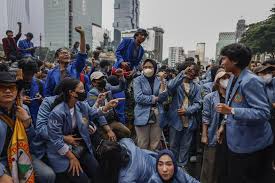
In recent days, Indonesia has witnessed a surge of student-led protests under the banner “Indonesia Gelap,” translating to “Dark Indonesia.” This movement, initiated by university students, reflects deep-seated concerns over governmental policies perceived as detrimental to the nation’s future.
The Genesis of “Indonesia Gelap”
The term “Indonesia Gelap” gained traction on social media platforms around February 3, 2025, rapidly becoming a trending topic. Students and activists employed this phrase to encapsulate their apprehensions about the country’s direction, especially in light of recent policy decisions.
Central to the unrest is the government’s announcement of budget cuts across various sectors, notably education. Students argue that such reductions jeopardize the quality of education and, by extension, the nation’s future. The Badan Eksekutif Mahasiswa Universitas Indonesia (BEM UI) has been at the forefront, organizing mass demonstrations to voice these concerns.
The Protests Unfold
On February 17, 2025, thousands of students converged in front of the Istana Merdeka in Jakarta. Clad in black attire and their university’s signature yellow jackets, they carried banners and chanted slogans demanding governmental accountability. Their primary grievances include:
-
Reversal of Budget Cuts: Advocating for the reinstatement of funds, particularly in the education sector.
-
Transparency in Policy Formulation: Urging the government to engage in open dialogues with stakeholders before implementing significant policy changes.
-
Protection of Civil Liberties: Expressing concerns over perceived erosions of democratic freedoms.
These demonstrations were not confined to Jakarta. Cities such as Bandung, Semarang, Surabaya, and Denpasar witnessed similar gatherings, underscoring the widespread nature of the dissent. In Bandung, for instance, students rallied in front of the West Java Regional House of Representatives, highlighting issues from budget cuts to the protection of migrant workers.
Government’s Response
In the face of mounting protests, State Secretary Prasetyo Hadi appealed to the public to grant President Prabowo’s administration time to address the nation’s challenges. He emphasized the government’s commitment to seeking solutions and urged for patience and constructive dialogue.
However, many students remain skeptical. The rapid implementation of policies without adequate public consultation has eroded trust, leading to calls for more immediate and tangible actions rather than assurances.
A Broader Reflection
The “Indonesia Gelap” movement is emblematic of a broader sentiment among the youth—a yearning for a government that is transparent, accountable, and attuned to the needs of its populace. The protests serve as a poignant reminder of the vital role that civic engagement plays in shaping a nation’s trajectory.
As Indonesia stands at this crossroads, the voices echoing from its streets highlight the urgency for policies that prioritize the welfare of its citizens. The nation’s future hinges on bridging the chasm between governmental actions and public expectations, ensuring that the path forward is illuminated by mutual understanding and collaboration.
